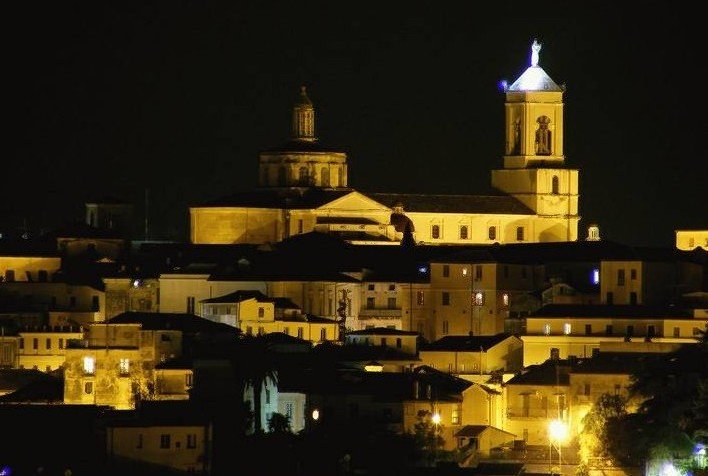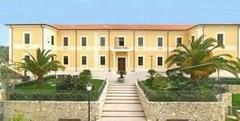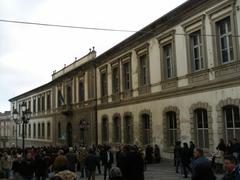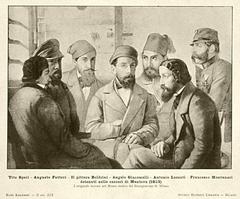
Cathedral of Catanzaro Visiting Hours, Tickets, and Historical Sites Guide
Date: 04/07/2025
Introduction
Nestled in the heart of Calabria’s historic center, the Cathedral of Catanzaro—also known as the Cathedral of Santa Maria Assunta or Duomo di Catanzaro—stands as a monumental emblem of the region’s rich religious, cultural, and architectural heritage. With origins dating back to the early 12th century, the cathedral reflects Catanzaro’s layered history, displaying influences from the Byzantine and Norman periods through Renaissance and Baroque artistry. As the seat of the Archdiocese of Catanzaro-Squillace, it remains a vibrant spiritual hub for the local community and pilgrims, anchoring liturgical celebrations such as the Feast of the Immaculate Conception and honoring Saint Vitalian, whose relics are preserved within its sacred walls.
Today, visitors will find a harmonious blend of Romanesque foundations, Renaissance façades, and Baroque interior decoration, complemented by significant chapels, such as those dedicated to Saint Vitalian and the Blessed Sacrament. Beyond its spiritual significance, the cathedral is central to Catanzaro’s cultural life, hosting events, processions, and fostering community dialogue.
This comprehensive guide consolidates historical insights, practical visitor information, and cultural highlights to help you plan a meaningful visit to one of Calabria’s most treasured landmarks. For further details and updates, consult trusted sources such as Life in Italy, Religiana, and the official Calabria tourism portal.
Historical Overview
Origins and Early History
Founded in 1121, the Cathedral of Catanzaro emerged during the transition from Byzantine to Norman rule—a period that marked Catanzaro’s rise as a significant religious and urban center (Life in Italy). The original structure showcased Romanesque features typical of Norman architecture, and its position in the city’s historic center symbolized both spiritual and civic authority (Wikipedia).
Architectural Evolution
The cathedral has undergone numerous transformations:
- Renaissance Renovations: A major rebuilding in the 16th century introduced Renaissance elements, including symmetrical façades and rounded arches, reflecting Catanzaro’s prosperity from the silk trade (Factsnippet).
- Baroque Additions: Later centuries brought Baroque interior decoration, elaborate stuccoes, gilded altars, and paintings of biblical scenes and local saints (Audiala).
- Restoration After Destruction: Earthquakes, especially in 1638, and WWII bombings in 1943 caused significant damage. Post-war restorations preserved historical character while integrating modern techniques for structural resilience (Life in Italy).
Religious and Cultural Significance
As the archbishop’s seat, the cathedral shapes Catanzaro’s religious and community life. It hosts major festivals and processions, including the annual celebration of the Assumption of the Virgin Mary and the patronal feast of Saint Vitalian, whose relics are enshrined here. The cathedral’s role extends beyond religion, serving as a venue for civic ceremonies and cultural events, reflecting the enduring legacy of Catanzaro’s artistry and resilience.
Architectural Features and Interior Highlights
Layout and Structure
The cathedral features a Latin cross floor plan with a central nave, two aisles, and a prominent bell tower. Its architecture blends Romanesque solidity, Renaissance elegance, and Baroque ornamentation, using local stone and marble that anchor it to Calabria’s landscape (Religiana; Calabria the Other Italy).
Notable Chapels
- Chapel of San Vitaliano: Built in 1309, this chapel houses the relics of Catanzaro’s patron saint and other local saints, attracting pilgrims especially during the annual feast (Religiana).
- Chapel of the Blessed Sacrament: Dating to 1588, this space marks the transition from Renaissance to Baroque, with an ornate altar and intricate stuccos.
Artistic Treasures
- Altars and Liturgical Furnishings: The main altar, crafted from local marble and adorned with gilded accents, stands at the crossing of the nave and transept, with frescoes in the apse depicting the Virgin Mary and apostles (Religiana).
- Frescoes, Paintings, and Sculptures: The cathedral holds Renaissance and Baroque artworks, including frescoes, polychrome altars, and statues from the 16th and 17th centuries.
- The Bell Tower: Combining Norman solidity with decorative elements, the bell tower is a key city landmark (Calabria the Other Italy).
Symbolic and Decorative Elements
- Legend of the Wooden Ecclesiastics: Local folklore tells of wooden figures placed in the choir to simulate a full clergy, commemorated in local tradition (Calabria the Other Italy).
- Stained Glass Windows: Restored in the 20th century, these windows depict New Testament scenes and local saints, casting colorful light throughout the interior.
Restoration and Preservation
Ongoing restoration projects focus on structural reinforcement and the conservation of artworks, integrating modern materials with historical craftsmanship (Religiana).
Visiting the Cathedral of Catanzaro
Location and Getting There
The cathedral is centrally located in Piazza Duomo, within Catanzaro’s pedestrian-friendly historic center. It is easily accessible on foot from major city landmarks, with public transport connections to Catanzaro Lido and the main train station (Your Travel to Calabria). Paid parking is available nearby.
Visiting Hours
- Monday to Saturday: 9:00 AM – 12:30 PM and 4:00 PM – 7:00 PM
- Sunday and Religious Holidays: 7:00 AM – 1:00 PM and 4:00 PM – 8:00 PM
Note: Hours may vary on special occasions or during festivals; check the cathedral’s official channels or local tourism offices for updates.
Tickets and Entry
General admission is free. Donations are appreciated to support maintenance and restoration. Guided tours and access to special exhibitions may require advance booking and a small fee.
Guided Tours
Local guides and tourism offices offer tours focusing on the cathedral’s history, art, and architecture. Advance reservation is recommended, especially during peak seasons (Nomads Travel Guide).
Accessibility
The main entrance is wheelchair accessible, and designated seating is available. Some areas may be challenging due to uneven historic floors; visitors with mobility needs should inquire in advance.
Dress Code and Etiquette
Visitors should dress modestly—shoulders and knees covered, no hats inside, and avoid beachwear (Paul Marina; Love to Visit Italy). Quiet behavior is expected, especially during services.
Photography
Photography is permitted without flash or professional equipment, except during religious services. Commercial filming requires prior approval (Travelista).
Facilities
There are no on-site cafés or gift shops, but dining and shopping options are nearby. Public restrooms are available close to Villa Margherita and Piazza Matteotti.
Nearby Attractions
Enhance your visit by exploring other Catanzaro historical sites within walking distance:
- Norman-Swabian Castle
- Villa Margherita (public park)
- Museo delle Arti di Catanzaro
- Church of Santa Teresa (Over Your Place)
Festivals and Community Traditions
The cathedral is central to Catanzaro’s religious festivals:
- Feast of the Immaculate Conception (December 8): Procession and liturgical celebrations
- Feast of Saint Vitalian (July 16): Processions, music, and traditional foods
- Holy Week and Jubilee Year Events: Unique rituals and enhanced cultural programs (Calabria Extraordinary)
Pilgrimage and Spiritual Tourism
As a basilica and diocesan cathedral, Catanzaro’s cathedral is a significant pilgrimage destination, especially during Jubilee years and major feasts. Pilgrims can obtain plenary indulgences and participate in special liturgies. The cathedral is often visited alongside other regional sites, such as the Shrine of the Madonna di Porto di Gimigliano (Calabria Extraordinary).
Frequently Asked Questions (FAQ)
Q: What are the Cathedral of Catanzaro’s visiting hours?
A: Monday–Saturday: 9:00 AM–12:30 PM and 4:00 PM–7:00 PM; Sundays and holidays: 7:00 AM–1:00 PM and 4:00 PM–8:00 PM. Hours may vary during special events.
Q: Is there an entry fee?
A: General entry is free. Guided tours or special events may require tickets.
Q: Are guided tours available?
A: Yes, through local tourism offices or private guides with advance booking recommended.
Q: Is the cathedral accessible for visitors with disabilities?
A: The main entrance has ramps and there is designated seating, but some areas may be less accessible due to historic architecture.
Q: Can I take photos inside?
A: Yes, without flash or professional equipment. Photography during services is discouraged.
Q: Where is the cathedral located?
A: In Piazza Duomo, Catanzaro historic center, easily reachable on foot or by public transportation.
Practical Tips for a Memorable Visit
- Visit on weekday mornings for a quieter experience.
- Dress modestly; bring a scarf or shawl for coverage.
- Combine your visit with a walking tour of the historic center.
- Check festival dates to experience local traditions.
- Use guidebooks or audio guides to enrich your visit.
- Respect local customs and participate in community events when possible.
Visuals and Interactive Resources
The majestic façade of the Cathedral of Catanzaro, a central landmark in Calabria.
Interior view showcasing the cathedral’s architectural details and stained-glass windows.
Interactive map of Catanzaro historic center and Cathedral location
Summary
The Cathedral of Catanzaro stands as a profound symbol of faith, history, and culture in Calabria. Its centuries-old stones narrate stories of resilience and artistic evolution, serving as both a spiritual sanctuary and a cultural beacon. With accessible visiting hours, free general admission, guided tours, and accommodations for visitors with disabilities, the cathedral welcomes everyone to explore its chapels, treasured artworks, and vibrant traditions. Its proximity to other historical sites like the Norman-Swabian Castle and local museums further enriches your cultural journey in Catanzaro.
For up-to-date information, guided tour bookings, and exclusive content, download the Audiala app and follow official social media channels. Discover the enduring spirit of Catanzaro through its iconic cathedral—a living monument of Calabria’s heritage and faith.
Sources and Further Information
- Life in Italy
- Wikipedia
- Factsnippet
- Audiala
- Religiana
- Calabria the Other Italy
- Calabria Extraordinary
- Your Travel to Calabria
- Nomads Travel Guide
- Travel to Italy Guide
- Paul Marina
- Love to Visit Italy
- Travelista
- Over Your Place





